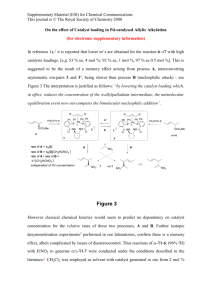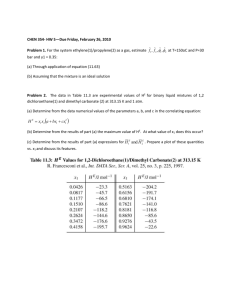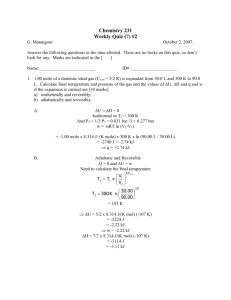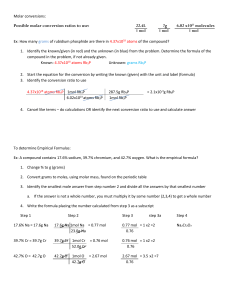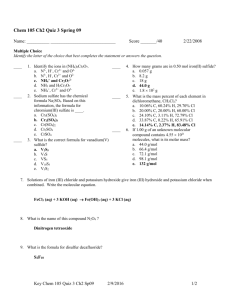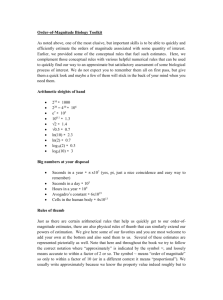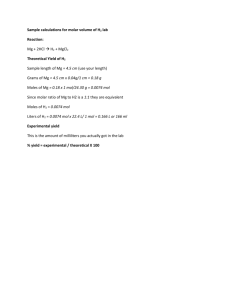KEY
advertisement
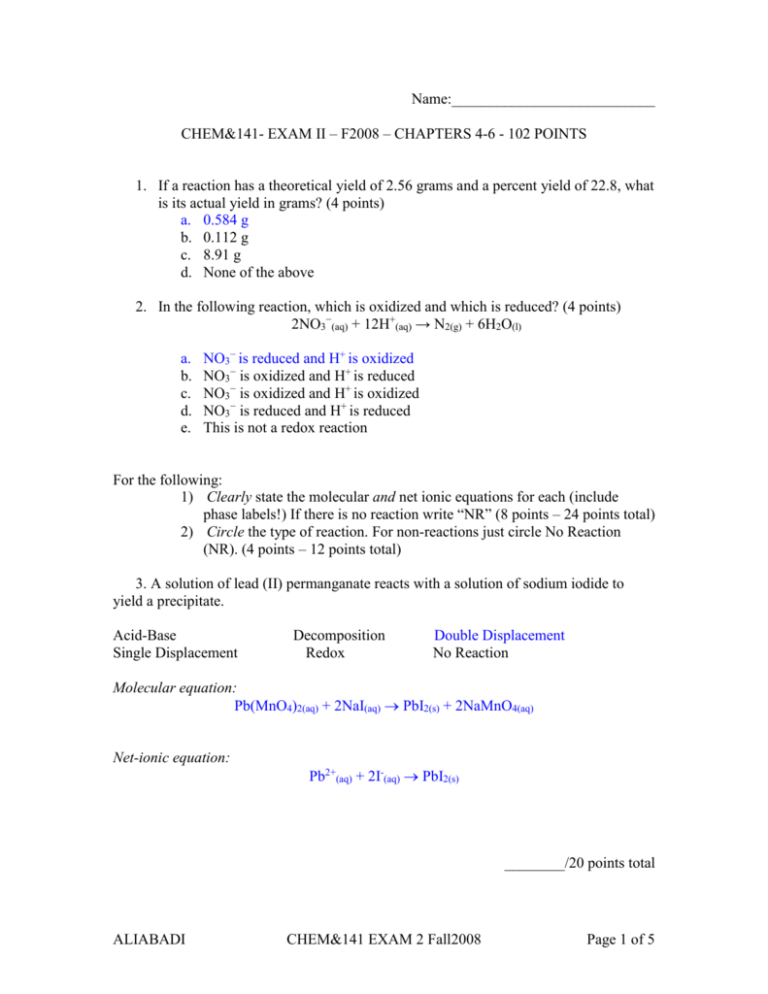
Name:___________________________ CHEM&141- EXAM II – F2008 – CHAPTERS 4-6 - 102 POINTS 1. If a reaction has a theoretical yield of 2.56 grams and a percent yield of 22.8, what is its actual yield in grams? (4 points) a. 0.584 g b. 0.112 g c. 8.91 g d. None of the above 2. In the following reaction, which is oxidized and which is reduced? (4 points) 2NO3−(aq) + 12H+(aq) → N2(g) + 6H2O(l) a. b. c. d. e. NO3− is reduced and H+ is oxidized NO3− is oxidized and H+ is reduced NO3− is oxidized and H+ is oxidized NO3− is reduced and H+ is reduced This is not a redox reaction For the following: 1) Clearly state the molecular and net ionic equations for each (include phase labels!) If there is no reaction write “NR” (8 points – 24 points total) 2) Circle the type of reaction. For non-reactions just circle No Reaction (NR). (4 points – 12 points total) 3. A solution of lead (II) permanganate reacts with a solution of sodium iodide to yield a precipitate. Acid-Base Single Displacement Decomposition Redox Double Displacement No Reaction Molecular equation: Pb(MnO4)2(aq) + 2NaI(aq) PbI2(s) + 2NaMnO4(aq) Net-ionic equation: Pb2+(aq) + 2I-(aq) PbI2(s) ________/20 points total ALIABADI CHEM&141 EXAM 2 Fall2008 Page 1 of 5 4. Calcium metal is placed in water yielding insoluble calcium hydroxide and hydrogen gas. Acid-Base Decomposition Double Displacement Single Displacement Redox No Reaction Molecular equation: Ca(s) + 2H2O(l) Ca(OH)2(s) + H2(g) Net-ionic equation: Ditto 5. Calculate Hrxn, in kJ, for the following reaction: (10 points) ½ N2(g) + ½ O2(g) NO(g) Given: N2(g) + 3H2(g) 2NH3(g); H = -91.8 kJ 4NH3(g) + 5O2(g) 4NO(g) + 6H2O(g); H = -906.2 kJ H2(g) + ½ O2(g) H2O(g); H = -241.8 kJ 2N2(g) + 6H2(g) 4NH3(g); H = -91.8 kJ x 2 = -183.6 kJ 4NH3(g) + 5O2(g) 4NO(g) + 6H2O(g); H = -906.2 kJ 6H2O(g) 6H2(g) + 3O2(g); H = +241.8 kJ x 6 2N2(g) + 2O2(g) 4NO(g); 361.0 kJ Divide by 4 ½ N2(g) + ½ O2(g) NO(g); 90.3 kJ _________/22 points total ALIABADI CHEM&141 EXAM 2 Fall2008 Page 2 of 5 6. 0.149 grams of quicksilver is placed in a coffee-cup calorimeter and then 125.0 mL of 1.00 M HCl is added. The reaction that occurs is: Hg(l) + 2HCl(aq) HgCl2(aq) + H2(g) The temperature of the solution increases from 25.89°C to 27.09°C. What is the enthalpy change for the reaction per mole of Hg? Assume that the specific heat capacity of the solution is 4.184 J/g°C and the density of the HCl solution is 1.00 g/mL. (MW of Hg = 200.59 g/mol) (10 points) qsoln mC T (1.00 g mL 125.0mL) (4.184 J g C )(1.25 C ) 628 J qsoln qrxn 628 J H rxn 628 J 200.59 g 8.45 105 J mol Hg 0.149 g mol Hg 7. Hydrated nickel (II) chloride is a beautiful, green, crystalline compound. If 0.235g of this hydrate is heated, it will leave 0.128g of the salt behind. What is the formula of the hydrated compound? (MW of NiCl2 = 129.5988 g/mol & MW of H2O = 18.0153 g/mol) (10 points) 0.128 g NiCl2 1mol NiCl2 9.88 104 mol NiCl2 129.5988g NiCl2 0.235 g 0.128 g 0.107g H 2O 0.107g H 2O 1mol H 2 O 5.94 103 mol H 2O 18.0153 g H 2 O 9.88 104 mol 6.01 6 5.94 103 mol Thus, chemical formula = NiCl2 6H 2 O ______/20 points total ALIABADI CHEM&141 EXAM 2 Fall2008 Page 3 of 5 8. 0.050 L of a solution of 1.03 M NiCl2 is mixed with 0.065 L of a solution of 1.13 M Hg2(NO3)2. What is the mass, in grams, of the precipitate produced? Hg2Cl2 = 472.09 g/mol, Ni(NO3)2 = 182.7033 g/mol. (10 points) NiCl2(aq) + Hg2(NO3)2(aq) Ni(NO3)2(aq) + Hg2Cl2(s) 1.03mol NiCl2 1molHg 2Cl2 472.09 gHg 2Cl2 NiCl2 : 0.050 L 24 gHg 2Cl2 1L 1molNiCl2 1molHg 2Cl2 Hg 2 ( NO3 ) 2 : 0.065 L 1.13mol NiCl2 1molHg 2Cl2 472.09 gHg 2Cl2 35 gHg 2Cl2 1L 1molNiCl2 1molHg 2Cl2 Thus, mass of precipitate produced is 24g. 9. A self-contained underwater breathing apparatus uses canisters containing potassium superoxide. The superoxide consumes the carbon dioxide exhaled by a person and replaces it with oxygen according to the equation below: 4KO2(s) + 2CO2(g) 2K2CO3(s) + 3O2(g) What mass of the superoxide, in grams, is required to react with 8.90 L of carbon dioxide at 22.0 °C and 767 mm Hg, where 760 mmHg = 1.00 atm? (MW of KO2 = 71.0971 g/mol & R = 0.08206 Latm/molK) (10 points) PV nRT 1atm ) 8.90 L PV 760mmHg n 0.371moles CO 2 L atm RT (0.08206 )(295.2 K ) mol K 4 mol KO 2 71.0971g KO 2 0.371moles CO 2 52.8g superoxide 2 mol CO 2 1mol KO 2 (767mmHg _____________/20 points total ALIABADI CHEM&141 EXAM 2 Fall2008 Page 4 of 5 10. Eugenol is the major component in oil of cloves. It has a molar mass of 164.2 g/mol and is 73.14% C, 7.37% hydrogen, and 19.49% oxygen. What are the empirical and molecular formulae of eugenol? (10 points) 1mol 73.14 gC 6.089molC 1.218mol 4.999C 5C 12.011g 1mol 7.37 gH 7.31molH 1.218mol 6 H 1.00794 g 1mol 19.49 gO 1.218molH 1.218mol 1H 15.9994 g Thus, empirical formula = C5 H 6O empirical formula mass = 82.102 g mol 164.2 g mol 2.000 g 82.102 mol And that makes the molecular formula = C10 H12 O 2 n 11. A small bubble rises from the bottom of a lake, where the temperature and pressure are 8°C and 6.4 atm, to the water’s surface, where the temperature is 25° and the pressure is 1.0 atm. Calculate the final volume of the bubble if its initial volume was 2.1mL. (10 points) PV PV 1 1 2 2 T1 T2 (6.4atm)(2.1mL) (1.0atm)V2 (281K ) (298 K ) V2 14mL ___________/20 points total ALIABADI CHEM&141 EXAM 2 Fall2008 Page 5 of 5

